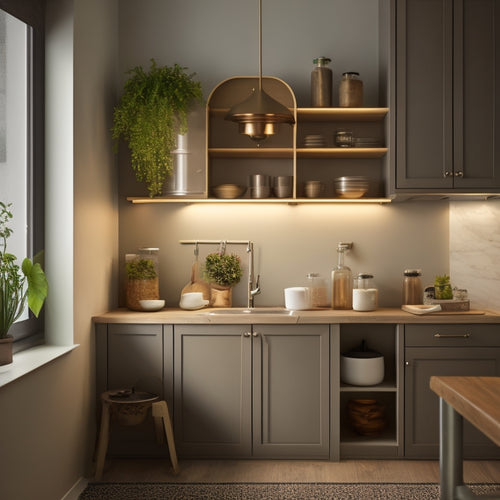
Transform Your Space With Custom DIY Built-Ins
Share
I've stumbled upon a design secret that has completely transformed my living spaces: custom DIY built-ins that not only maximize storage but also infuse personality and style into every room. By repurposing salvaged materials and envisioning unique designs, I've created one-of-a-kind pieces that reflect my personal taste. From clever upper cabinet uses like window benches and storage units to meticulously planned installations, every detail matters. With a focus on balancing function and style, I've achieved spaces that are both beautiful and functional. As I continue to experiment and push boundaries, I uncover new possibilities for my dream space.
Key Takeaways
• Start with affordable unfinished cabinets from retailers like Lowes or Habitat Restore to create unique pieces reflecting your personal style.
• Measure and cut each piece precisely for a custom fit, focusing on cabinet customization for optimized space and added sophistication.
• Repurpose upper cabinets as window benches, storage units, or seating areas to maximize functionality and style in any room.
• Meticulously plan the installation process, ensuring accurate measurements, sturdy fastening, and consideration of weight capacity and flooring type.
• Balance function and style in your design, considering the room's purpose, your aesthetic, and user needs to create a harmonious and functional space.
Sourcing Essential Materials
When starting on a DIY built-in project, I always begin by scouring popular retailers like Lowes, Home Depot, Menards, Ikea, or Habitat Restore for affordable unfinished cabinets that can be transformed into custom masterpieces.
I'm on the hunt for bargain-friendly options that fit my budget, and I never overlook the potential of salvage projects. Upcycling materials not only saves me money but also adds a touch of uniqueness to my built-ins.
I carefully inspect each cabinet, imagining the possibilities of how I can elevate it with some TLC. With my finds, I can create a one-of-a-kind piece that reflects my personal style.
Building and Customizing Cabinets
With my unfinished cabinets in hand, I immerse myself in the build process, carefully measuring and cutting each piece to guarantee a precise fit, while envisioning the custom design that will soon take shape.
I focus on cabinet customization, optimizing every inch of space to create a seamless, streamlined look. To achieve this, I build in sections, taking precise measurements to ensure accuracy and stability. Thicker trim pieces add a touch of sophistication, while customizing shelf sizes allows me to tailor the design to the room's unique features.
Creative Upper Cabinet Uses
As I venture beyond traditional kitchen applications, I find that upper cabinets can be repurposed into functional and stylish built-ins, such as window benches, storage units, or even seating areas.
In playrooms, I use upper cabinets to create custom storage solutions, keeping toys and supplies organized and out of sight.
In garages, I transform them into clever organization systems, complete with bins and baskets for tools and equipment.
Window benches become cozy nooks for reading or relaxation, while built-in islands provide additional counter space and seating.
Tips for Successful Installation
I guarantee a seamless installation by meticulously planning every step, from measuring the space to securing the cabinets to the wall, to avoid costly mistakes and guarantee a sturdy, long-lasting built-in.
To achieve this, I prioritize proper anchoring and stability by making sure the cabinets are securely fastened to the wall studs.
Measuring accuracy is vital, so I double-check my measurements to ensure precision.
I also take into consideration the weight capacity of the shelves and the type of flooring I'm working with.
Designing for Function and Style
When designing custom DIY built-ins, I balance function and style by carefully considering the room's purpose, my personal aesthetic, and the needs of the people who'll be using the space.
I visualize how the built-ins will flow with the existing furniture and decor, ensuring a harmonious blend of form and function.
To maximize storage, I strategically place shelves, drawers, and cabinets, taking into account the items that need to be stored.
Incorporating lighting is also essential, as it can make or break the ambiance of the space. I choose lighting fixtures that not only provide adequate illumination but also add a touch of sophistication and style.
Frequently Asked Questions
Can I Use MDF or Plywood for DIY Built-In Shelves Instead of Solid Wood?
I opt for MDF or plywood for DIY built-in shelves, as they're cost-effective and easier to work with than solid wood, plus they take paint beautifully, whereas stain can accentuate their imperfections.
How Do I Properly Secure Built-Ins to a Load-Bearing Wall?
I know what you're thinking, 'Will my built-ins come crashing down?' But trust me, with proper anchoring techniques, I guarantee stability by distributing weight evenly and reinforcing the wall with sturdy screws and wall anchors.
Are There Any Local Building Codes or Regulations I Need to Follow?
Before I start building, I research local permit requirements and safety regulations to confirm compliance, avoiding costly mistakes and potential hazards, and guaranteeing a sturdy, code-compliant DIY built-in that's both beautiful and safe.
Can I Install Built-Ins on a Slanted or Uneven Wall?
As I commence on this DIY adventure, I'm tackling the obstacle of slanted walls head-on, utilizing spacers and creative solutions to customize angles and overcome unique challenges, ensuring my built-ins fit like a puzzle piece.
Do I Need to Add Any Electrical Outlets or Lighting to My Built-In Design?
As I design my built-in, I'm considering adding electrical outlets and lighting options to enhance functionality and ambiance, ensuring a seamless space transformation that's both beautiful and practical.
Related Posts
-

Corner Kitchen Storage Hacks: Expert Guide Inside
You're tired of the clutter and wasted space in your kitchen corners. It's time to transform them into functional and...
